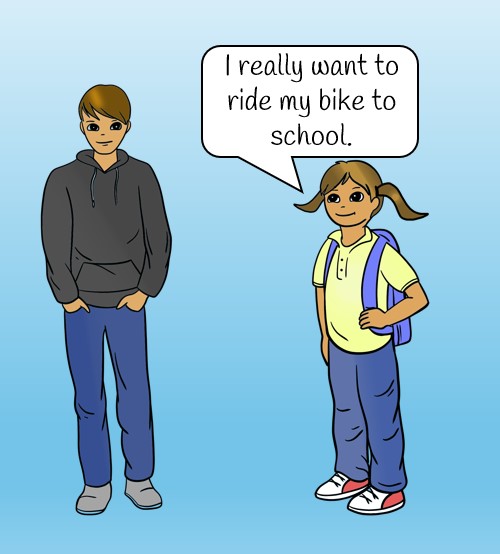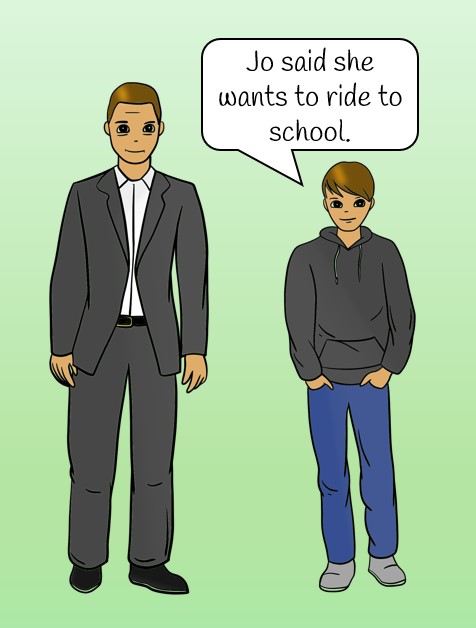Reported Speech Activities
When we use reported speech we convey what someone else has said without quoting them directly. Let’s image the following scenario in which a sister is talking to her brother:

Here we can see the direct speech (“I really want to ride my bike to school.”). Now let’s image the brother is reporting this speech to their father. Notice he doesn’t use the exact words his sister used. This is an example of reported speech.

Reported Speech is an English grammar structure used to convey what someone else has said without quoting them directly. Instead, we use our own words to relay their message. To use reported speech, we need to make some changes to pronouns, verb tenses, and time expressions.
Before we dive in, let’s take a look at a few examples for affirmative and negative statements:
| Direct Speech | Reported Speech |
| (Marta) “I wanted to be a dentist when I was young.” | Marta said she had wanted to be a dentist when she was young. |
| (Lily to me) “I am not learning English.” | Lily told me she was not learning English. |
| (Molly to Evie) “I have visited China.” | Molly told Evie she had visited China. |
When changing direct speech to reported speech we need to follow six steps:
INSERT IMAGE OF STEPS
Step 1: Choose a Reporting Verb
In reported speech, we need a reporting verb to introduce the sentence. Common reporting verbs include:
- said
- told
- asked
- explained
- advised
For example:
Direct speech: She said, “I am studying.”
Reported speech: She said (that) she was studying.
There are many reporting verbs we can choose from, but the most common are say and tell in their past form: said and told. When we use told we always need to mention to whom the message was told. For example: Martha told me, Or Peter told Mary. For this, we’ll need to remember our object pronouns (e.g., me, her, his, them, us).
Step 2: Backshift Verb Tense
In reported speech, we often change the verb tense from the present to the past. Here’s the usual pattern for tense changes:
| Tense in Original (Direct) Speech | Tense to Use in Reported Speech |
| Present Simple | Past Simple |
| Present Continuous | Past Continuous |
| Past Simple | Past Perfect |
| Past Continuous | Past Perfect Continuous |
| Present Perfect | Past Perfect |
| Present Perfect Continuous | Past Perfect Continuous |
| Past Perfect | Past Perfect |
| Will | Would |
Step 3: Perspective (Adjust Pronouns)
Change the pronouns in the direct speech to match the perspective of the person reporting the speech.
- I becomes he/she,
- you becomes I/we (depending on the speaker),
- we becomes they,
- my becomes his/her,
- your becomes my.
For example:
Direct speech: “I am going to your party,” he said.
Reported speech: He said (that) he was coming to my party.
Step 4: Adjust Time Expressions
Time expressions (such as now, today, tomorrow, etc.) often change when converting to reported speech. Here are some common changes:
| Time Expression Used in Direct Speech | Time Expression to Use in Reported Speech |
| now | then |
| today | that day |
| tomorrow | the next day |
| yesterday | the day before |
| next week | the following week |
| here | there |
| this | that |
Here are some examples of these changes:
Direct Speech: “I have a meeting today.”
Reported Speech: She said she had a meeting that day.
Direct Speech: “I’ll call you tomorrow.”
Reported Speech: He said he would call me the next day.
Direct Speech: “I saw her yesterday.”
Reported Speech: She said she had seen her the day before.
Direct Speech: “The keys are here.”
Reported Speech: He said the keys were there.
Direct Speech: “I love this book.”
Reported Speech: She said she loved that book.
Video: How to Use Reported Speech
EMBED VIDEO HERE
More Reported Speech Practice
Reported Speech Quiz
Ready to put what you’ve learned about reported speech into practice? Take the quiz!
Make sure you keep reviewing the video, worksheets and quiz to consolidate your understanding of reported speech. If you feel ready to move on, choose a topic below to keep improving your English!
